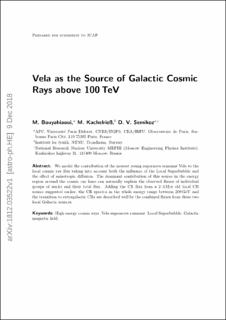| dc.contributor.author | Bouyahiaoui, M. | |
| dc.contributor.author | Kachelriess, Michael | |
| dc.contributor.author | Semikoz, D. V. | |
| dc.date.accessioned | 2020-08-24T08:33:49Z | |
| dc.date.available | 2020-08-24T08:33:49Z | |
| dc.date.created | 2019-07-01T11:07:44Z | |
| dc.date.issued | 2019 | |
| dc.identifier.citation | Journal of Cosmology and Astroparticle Physics. 2019, 2019 (1), . | en_US |
| dc.identifier.issn | 1475-7516 | |
| dc.identifier.uri | https://hdl.handle.net/11250/2673523 | |
| dc.description.abstract | We model the contribution of the nearest young supernova remnant Vela to the local cosmic ray flux taking into account both the influence of the Local Superbubble and the effect of anisotropic diffusion. The magnetic field in the bubble wall prevents low-energy particles to penetrate into the bubble, leading to an energy-dependent suppression of CRs from Vela inside the bubble. The resulting CR flux at Earth in the energy region around the cosmic ray knee can naturally explain the observed fluxes of individual groups of nuclei and their total flux. Adding the CR flux from a 2–3 Myr old local CR source suggested earlier, the CR spectra in the whole energy range between 200 GeV and the transition to extragalactic CRs are described well by the combined fluxes from these two local Galactic sources. | en_US |
| dc.language.iso | eng | en_US |
| dc.publisher | IOP Publishing | en_US |
| dc.title | Vela as the source of Galactic cosmic rays above 100 TeV | en_US |
| dc.type | Journal article | en_US |
| dc.description.version | submittedVersion | en_US |
| dc.source.pagenumber | 11 | en_US |
| dc.source.volume | 2019 | en_US |
| dc.source.journal | Journal of Cosmology and Astroparticle Physics | en_US |
| dc.source.issue | 1 | en_US |
| dc.identifier.doi | 10.1088/1475-7516/2019/01/046 | |
| dc.identifier.cristin | 1708980 | |
| dc.description.localcode | © 2019. This is the authors' manuscript to the article. | en_US |
| cristin.unitcode | 194,66,20,0 | |
| cristin.unitname | Institutt for fysikk | |
| cristin.ispublished | true | |
| cristin.fulltext | preprint | |
| cristin.qualitycode | 1 | |
